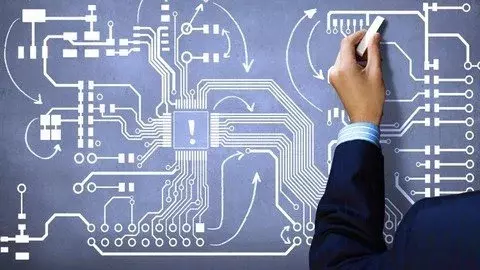Comsol Multiphysics For Electronic Engineers
Electronic device simulation by COMSOL
What you'll learn
Complete understanding of COMSOL software
How to use parameters and variables
Learn to use global and local functions such as rectangular, Gaussian, sinusoidal, etc
Learn to use geometrics
How to use 1D, 2D, 3D plot group?
How to simulate electronic devices such as diode, BJT, EEPROM?
How to use Mesh Attribute and Mesh operation?
Be able to define various boundary conditions in COMSOL
10- You will be familiar with Study and Results nodes in COMSOL

Requirements
You need a computer.
You need an internet connection to download.
Description
Device engineers and physicists use the Semiconductor Module of COMSOL Multiphysics to design, simulate, and understand semiconductor devices.
Multiphysics effects often play an important role in semiconductor devices, and COMSOL Multiphysics is the ideal platform for investigating these effects.
COMSOL Multiphysics has a lot of tools that make work with software easier.
In this course, we will learn to simulate the stationary and dynamic performance of semiconductor devices in one, two, and three dimensions, with circuit-based modeling of active and passive devices.
To model a Semiconductor device, the geometry is first explained in the course.
Then appropriate materials for the Semiconductor interface are described.
The dopant distribution can be computed separately using a diffusion equation calculation.
Initial conditions and boundary conditions have strong effects on the solution and will be defined in the course.
Next, the mesh is defined and a solver is selected.
Finally, the results are visualized using a wide range of plotting and evaluation tools.
After the description of basic tools, we will design some electronic components with COMSOL Multiphysics.
Electronic devices such as p-n junction diode, Bipolar junction transistor(BJT), metal-oxide-semiconductor FET (MOSFET), MESFET, erasable programmable read only memory (EEPROM,) etc.
Also, monthly new examples will be added to this course.
Overview
Section 1: Introduction
Lecture 1 Introduction
Section 2: COMSOL Basic Tools
Lecture 2 Introduction
Lecture 3 How to install COMSOL
Lecture 4 Model Wizard in COMSOL
Lecture 5 Parameters and Variables in COMSOL
Lecture 6 Functions in COMSOL
Lecture 7 Basic Geometry in COMSOL
Lecture 8 Advanced Geometry in COMSOL
Section 3: COMSOL Semiconductor Interface
Lecture 9 Introduction
Lecture 10 Semiconductor Material Models in COMSOL
Lecture 11 Semiconductor doping definition in COMSOL
Lecture 12 Generation-Recombination Models in Semiconductors
Lecture 13 Semiconductor Boundary Conditions in COMSOL
Lecture 14 Meshing Attributes in COMSOL
Lecture 15 Meshing Operations in COMSOL
Lecture 16 Study node in COMSOL Multiphysics
Lecture 17 Simulation Results in COMSOL
Section 4: COMSOL Examples
Lecture 18 Introduction
Lecture 19 Design p-n junction (diode) by COMSOL
Lecture 20 Diode Results
Device engineers and physicists,Who want to understand semiconductor physics with COMSOL,Who want to do their thesis based on device simulation,Electronic Engineers,Semiconductor chip manufactures,Academic researchers
Published 11/2023
MP4 | Video: h264, 1920x1080 | Audio: AAC, 44.1 KHz
Language: English | Size: 1.3 GB | Duration: 2h 40m
Download
http://s19.alxa.net/one/2023/11/COM....Engineers.rar
Electronic device simulation by COMSOL
What you'll learn
Complete understanding of COMSOL software
How to use parameters and variables
Learn to use global and local functions such as rectangular, Gaussian, sinusoidal, etc
Learn to use geometrics
How to use 1D, 2D, 3D plot group?
How to simulate electronic devices such as diode, BJT, EEPROM?
How to use Mesh Attribute and Mesh operation?
Be able to define various boundary conditions in COMSOL
10- You will be familiar with Study and Results nodes in COMSOL

Requirements
You need a computer.
You need an internet connection to download.
Description
Device engineers and physicists use the Semiconductor Module of COMSOL Multiphysics to design, simulate, and understand semiconductor devices.
Multiphysics effects often play an important role in semiconductor devices, and COMSOL Multiphysics is the ideal platform for investigating these effects.
COMSOL Multiphysics has a lot of tools that make work with software easier.
In this course, we will learn to simulate the stationary and dynamic performance of semiconductor devices in one, two, and three dimensions, with circuit-based modeling of active and passive devices.
To model a Semiconductor device, the geometry is first explained in the course.
Then appropriate materials for the Semiconductor interface are described.
The dopant distribution can be computed separately using a diffusion equation calculation.
Initial conditions and boundary conditions have strong effects on the solution and will be defined in the course.
Next, the mesh is defined and a solver is selected.
Finally, the results are visualized using a wide range of plotting and evaluation tools.
After the description of basic tools, we will design some electronic components with COMSOL Multiphysics.
Electronic devices such as p-n junction diode, Bipolar junction transistor(BJT), metal-oxide-semiconductor FET (MOSFET), MESFET, erasable programmable read only memory (EEPROM,) etc.
Also, monthly new examples will be added to this course.
Overview
Section 1: Introduction
Lecture 1 Introduction
Section 2: COMSOL Basic Tools
Lecture 2 Introduction
Lecture 3 How to install COMSOL
Lecture 4 Model Wizard in COMSOL
Lecture 5 Parameters and Variables in COMSOL
Lecture 6 Functions in COMSOL
Lecture 7 Basic Geometry in COMSOL
Lecture 8 Advanced Geometry in COMSOL
Section 3: COMSOL Semiconductor Interface
Lecture 9 Introduction
Lecture 10 Semiconductor Material Models in COMSOL
Lecture 11 Semiconductor doping definition in COMSOL
Lecture 12 Generation-Recombination Models in Semiconductors
Lecture 13 Semiconductor Boundary Conditions in COMSOL
Lecture 14 Meshing Attributes in COMSOL
Lecture 15 Meshing Operations in COMSOL
Lecture 16 Study node in COMSOL Multiphysics
Lecture 17 Simulation Results in COMSOL
Section 4: COMSOL Examples
Lecture 18 Introduction
Lecture 19 Design p-n junction (diode) by COMSOL
Lecture 20 Diode Results
Device engineers and physicists,Who want to understand semiconductor physics with COMSOL,Who want to do their thesis based on device simulation,Electronic Engineers,Semiconductor chip manufactures,Academic researchers
Published 11/2023
MP4 | Video: h264, 1920x1080 | Audio: AAC, 44.1 KHz
Language: English | Size: 1.3 GB | Duration: 2h 40m
Download
http://s19.alxa.net/one/2023/11/COM....Engineers.rar